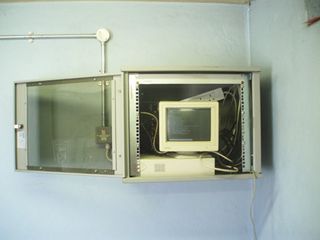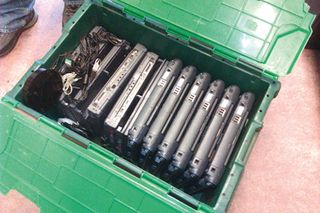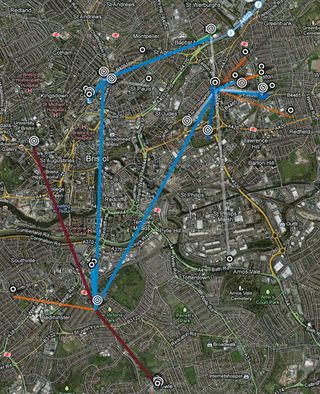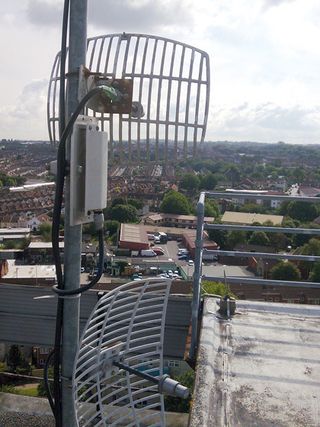Bristol's community-built wireless network
How volunteers run an innovative community project
Usually at this point, plans are scuppered by British bureaucracy, health and safety laws or Nimby (Not In My Back Yard) attitudes. But you'll be pleased to learn that the council supported the project, gave access to the tower's roof, and the network continued to spread: from this point, the furthest it could reach was Long Ashton, a distance of almost five miles.

DAYS GONE PAST: An early router, including CRT monitor!
This all took place in Bristol Wireless's first few years and now the project is rapidly approaching its 10th birthday, so what's happened in between?
A significant development came out of the project's natural growth. As it served more and more people with internet, it outgrew ECC's 2.2Mbps connection, and now uses its wireless network to provide access to the Broadband Media Exchange's (BMEX) highspeed network. Bristol Wireless now provides many community projects with a symmetric connection burstable up to 10Mbps.
This might not sound fast compared to advertised domestic connection speeds today, but the BMEX network achieves these speeds far more consistently and provides uploads at the same speed as downloads. This has also led to a change in the way the project is run.
The BMEX connection has to be paid for, as does the continuous maintenance and upgrading of the antennas and routers across the city, so Bristol Wireless's services are now paid for. It's still staffed by volunteers and it doesn't turn a profit but it provides third-sector organisations with the cheapest IT solutions possible.
IT solutions is the correct phrase, too, since the team has, over the years, expanded its services in response to shifting demands. Starting from the deployment of those two Red Hat boxes, the team has gradually developed its knowledge of LTSP, the Linux Terminal Server Project. This means lots of people can use the same computer at the same time.
Get daily insight, inspiration and deals in your inbox
Get the hottest deals available in your inbox plus news, reviews, opinion, analysis and more from the TechRadar team.
All the applications run on a server, which is then accessed through a thin client - a very low-powered computer that links the server with individual input and output devices. As Andy points out: "Originally it was a great way of disseminating bandwidth at our public access locations." They might not be powerful, but in locations where all that's needed is some internet, document editing or image viewing, they're the ideal solution: they're cheap, and can use as little as 11W while operating.
One of the team's more original endeavours was the creation of a mobile LTSP suite. It's not much more than half a dozen old laptops, a few extension leads and plenty of network cable all tucked into a box, but it's proved to be a very popular solution for events across the country.

MOBILE WI-FI: An LTSP suite - great for protests in fields
At the Climate Camps, for instance, the team was contracted to provide network access. They took along their mobile LTSP suite, powered it with some small solar panels and wind turbines, and connected it to the internet through a satellite link. This enabled protestors to communicate with the outside world, providing an alternative to the mainstream media.
The team has also started venturing into VoIP, using the Bath-based Gradwell trunk network to connect clients to the outside world. As you'd imagine, its solution continues to be entirely built around free and open source software and uses the FreePBX distribution as the switch.

THE BRISTOL NETWORK: The current extent of Bristol Wireless's network
Today, customers include the Cube Cinema, Fareshare SW, the ECC, St Werburghs City Farm and the Princess Royal Gardens sheltered accommodation, amongst many others. In effect, the team is now operating as a small, community telecoms provider, and since it's now supplying paying customers, quality of service is a matter of increasing concern.
In the interests of maintaining a quality network connection for as many groups as possible, Bristol Wireless does engage in active traffic management. The team uses Nagios to monitor the condition of the network and, if it sees a prolonged spike in network traffic, is happy to temporarily disconnect the source and ask what's going on. Without this, its VoIP service wouldn't be reliable, and there would be constant hassle from copyright holders.
Bristol Wireless's experience as a small ISP sheds some interesting light on the realities for larger internet companies too. The team sees great value in people being able to do whatever they like on the net, but when it comes to the day-to-day reality of ensuring that the network is always available, it's had to compromise on these ideals. It's no wonder then that larger businesses, who may or may not consider net neutrality important, need to implement traffic management policies, too.
As the project faced new challenges and sought to meet new community needs, the volunteers found themselves having to learn new skills. Indeed, many of the current crop started out with no formal training or qualifications, but relied on man pages and knowledgeable friends.
The sad death of a key engineer, Lloyd Cohen, and the departure of a number of other members, left the team feeling a bit vulnerable. With such a depleted pool of knowledge would the volunteers be able to properly maintain and support the network? It was a serious predicament, but one that was resolved thanks to the loyalty and goodwill of former staff.
A number of those who'd gone on to new jobs created a top-down, systematic course on networking to bring the remaining members up to speed. It started out with simple home networking and progressed all the way through to Class-C, B and A networks and how DNS works - all before lunch. After lunch, they then dived into their own network to see how it all worked in practice.
Not only did this, as Rich puts it, "good ethos of shared learning experiences" prove vital to the continued success of the project, it also acted as a springboard for other members to gain experience and go on to find professional employment.
Matt Leonard, who arrived to join us during his lunchbreak, was the project's wireless guru before getting a job as a network engineer. Now that he's back in the area, he's getting involved again. "It was an awesome playground," he said, reflecting on his experiences. "At least in the early days before it was so relied upon - you could really get stuck in to networking and play with it in the real world."
Now, approaching its 10th anniversary, Bristol Wireless finds itself at a bit of a crossroads. There are a number of new customers it's waiting to bring online and there are also some new projects it wants to pursue. In particular, it's interested in building an install-and-go LTSP solution.
Its great worry, though, is that there aren't enough volunteers with either the time or the expertise to make this a reality. In the past, the team looked to Pete Ferne, its charismatic chair and leader, but he passed away last year. Now it hopes to find someone new, with fresh ideas, energy and enthusiasm.

WIDE REACH: Antennas used as the network spread - a touch more sophisticated than the cantenna
Whatever happens, the project has certainly made an impact over the past ten years and hopefully it will continue to provide an invaluable service to many of Bristol's best third-sector organisations for the decade to come as well.
- 1
- 2
Current page: Expanding the Bristol Wireless network
Prev Page Bristol's community-built wireless networkMost Popular


